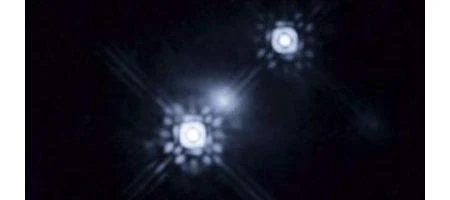A new technique to study the bright disc of matter surrounding a distant black hole is as precise as spotting individual grains of sand on the surface of the moon.

Using the NASA/ESA Hubble Space Telescope, combined with the gravitational lensing effect of stars in a distant galaxy, an international team of astronomers measured the disc’s size and studied the colors – and hence the temperatures – of different parts of the disc.
Quasars, or quasi-stellar objects, are glowing discs of matter that orbit supermassive black holes, heating up and emitting extremely bright radiation as they do so. But their size means there has been little opportunity to study them directly.
“A quasar accretion disc has a typical size of a few light-days, or around 100 billion kilometres across, but they lie billions of light-years away,” says study lead scientist Jose Muñoz.
“This means their apparent size when viewed from Earth is so small that we will probably never have a telescope powerful enough to see their structure directly.”
To get around this problem, the team therefore used the stars in an intervening galaxy as a scanning microscope to probe features in the quasar’s disc that would otherwise be far too small to see.
As the stars move across the light from the quasar, gravitational effects amplify the light from different parts of the quasar, giving detailed color information for a line that crosses through the accretion disc.
The team observed a group of distant quasars that are gravitationally lensed by the chance alignment of other galaxies in the foreground, producing several images of the quasar.
They spotted subtle differences in color between the images, and over time, partly caused by the properties of dust in the intervening galaxies.
For one of the quasars they studied, though, there were clear signs that stars in the intervening galaxy were passing through the path of the light from the quasar. The gravitational effect of the stars within the intervening galaxy subtly bends and amplifies the light from different parts of the accretion disc.
By recording the variation in colour, the team were able to reconstruct the colour profile across the accretion disc. Because the temperature of an accretion disc increases the closer it is to the black hole, the team could measure the diameter of the disc of hot matter, and plot how hot it is at different distances from the centre.
They found that the disc is between four and eleven light-days across – a remarkably accurate measurement for a small object at such a great distance.
“This result is very relevant because it implies we are now able to obtain observational data on the structure of these systems, rather than relying on theory alone,” says Muñoz.
“Quasars’ physical properties are not yet well understood. This new ability to obtain observational measurements is therefore opening a new window to help understand the nature of these objects.”






